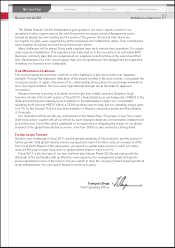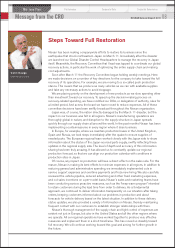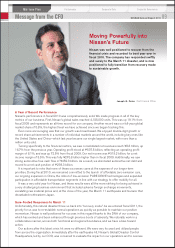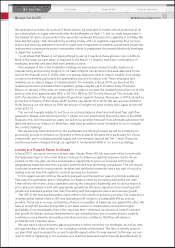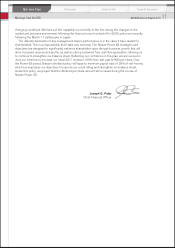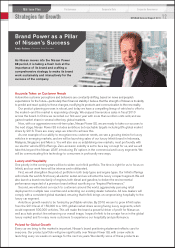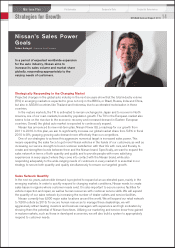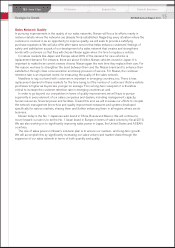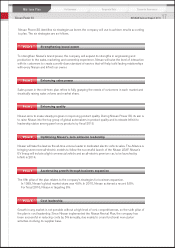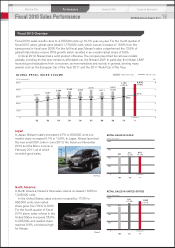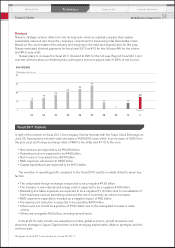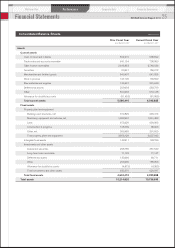Nissan 2011 Annual Report Download - page 18
Download and view the complete annual report
Please find page 18 of the 2011 Nissan annual report below. You can navigate through the pages in the report by either clicking on the pages listed below, or by using the keyword search tool below to find specific information within the annual report.
To strengthen Nissan’s brand power, the company will expand its strengths in engineering and
production to the sales, marketing and ownership experience. Nissan will raise the level of interaction
with its customers to create a world-class standard of service that will help build lasting relationships
with every Nissan and Infiniti car owner.
Sales power in the mid-term plan refers to fully grasping the needs of customers in each market and
drastically raising sales volume and market share.
Nissan aims to make steady progress in improving product quality. During Nissan Power 88, its aim is
to raise Nissan into the top group of global automakers in product quality and to elevate Infiniti to
leadership status among peer luxury products by fiscal 2016.
Nissan will take the lead as the all-time volume leader in dedicated electric vehicle sales. The Alliance is
bringing seven more all-electric models to follow the successful launch of the Nissan LEAF. Nissan’s
EV lineup will include a light commercial vehicle and an all-electric premium car, to be launched by
Infiniti in 2014.
The fifth pillar of the plan relates to the company’s strategies for business expansion.
In 1999, Nissan’s global market share was 4.6%. In 2010, Nissan achieved a record 5.8%.
For fiscal 2016, Nissan is targeting 8%.
Growth in any market is not possible without a high level of cost competitiveness, so the sixth pillar of
the plan is cost leadership. Since Nissan implemented the Nissan Revival Plan, the company has
been successful in reducing costs by 5% annually, due mainly to cross-functional monozukuri
activities involving its supplier base.
Pillar 1 Strengthening brand power
Pillar 2 Enhancing sales power
Pillar 3 Enhancing quality
Pillar 4 Optimizing Nissan’s zero-emission leadership
Pillar 5 Accelerating growth through business expansion
Pillar 6 Cost leadership
Pillar 1 Strengthening brand power
Pillar 2 Enhancing sales power
Pillar 3 Enhancing quality
Pillar 4 Optimizing Nissan’s zero-emission leadership
Pillar 5 Accelerating growth through business expansion
Pillar 6 Cost leadership
Pillar 1 Strengthening brand power
Pillar 2 Enhancing sales power
Pillar 3 Enhancing quality
Pillar 4 Optimizing Nissan’s zero-emission leadership
Pillar 5 Accelerating growth through business expansion
Pillar 6 Cost leadership
Pillar 1 Strengthening brand power
Pillar 2 Enhancing sales power
Pillar 3 Enhancing quality
Pillar 4 Optimizing Nissan’s zero-emission leadership
Pillar 5 Accelerating growth through business expansion
Pillar 6 Cost leadership
Pillar 1 Strengthening brand power
Pillar 2 Enhancing sales power
Pillar 3 Enhancing quality
Pillar 4 Optimizing Nissan’s zero-emission leadership
Pillar 5 Accelerating growth through business expansion
Pillar 6 Cost leadership
Pillar 1 Strengthening brand power
Pillar 2 Enhancing sales power
Pillar 3 Enhancing quality
Pillar 4 Optimizing Nissan’s zero-emission leadership
Pillar 5 Accelerating growth through business expansion
Pillar 6 Cost leadership
Nissan Power 88 identifies six strategies as levers the company will use to achieve results according
to plan. The six strategies are as follows.
Nissan Power 88
Mid-term Plan
Performance Corporate Data Corporate Governance
17
NISSAN Annual Report 2011


